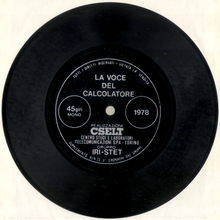MUSA (MUltichannel Speaking Automaton)

Audio disk containing "Fra Martino campanaro" sung by MUSA in 1978
MUSA (MUltichannel Speaking Automaton) was an early prototype of Speech Synthesis machine started in 1975.
Description
It consisted of a stand-alone computer hardware and a specialized software that implemented a diphone-synthesis technology. It was able to read italian in intellegibile robotic voice and also to sing managing up to 8 synthesis channels in parallel. In 1978 it was released, after the building of a working prototype[1], an 45" rpm audio disk containing some trial content of such synthesis, including the song "Fra Martino Campanaro" in "a cappella" (multiple voices) style, attached to some commercial reviews[2]. The experiment was conducted by CSELT, Turin, Italy and was led by Giulio Modena.
Related pages
Notes
- ↑ Billi, R., Canavesio, F., Ciaramella, A., & Nebbia, L. (1995). Interactive voice technology at work: The CSELT experience. Speech communication, 17(3-4), 263-271.
- ↑ (it) Cantoni, Virginio, Gabriele Falciasecca, and Giuseppe Pelosi, eds. Storia delle telecomunicazioni. Vol. 1. Firenze university press, 2011.
References
- Roberto Pieraccini, The voice and the Machine, MIT press, 2015, ISBN 0262533294.
External links
This article is issued from
Wikipedia.
The text is licensed under Creative Commons - Attribution - Sharealike.
Additional terms may apply for the media files.